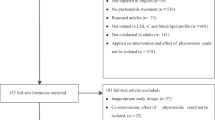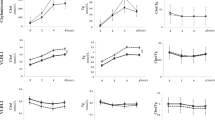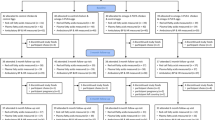Abstract
Objective:
We investigated the serum phytosterol responses of heterozygous relatives of sitosterolemia patients to diets enriched in phytosterols or stanols.
Design:
Randomized double-blind crossover design.
Setting:
Muenster, Germany.
Subjects:
Eight heterozygous and 13 control subjects were recruited. One heterozygote and three controls dropped out.
Interventions:
Seven heterozygotes and 10 controls received daily portions of margarine containing 2 g of plant sterols, 2 g of stanols or a control margarine for 6 weeks each in a randomized order. These phases were intercepted by wash-out periods of 6 weeks each.
Results:
Compared to the control period, serum phytosterol concentrations increased overall by more than 20% when subjects consumed the plant sterol margarine (F(1,15)=8.719, P=0.01), with no significant difference between heterozygotes (mean +14.5 (s.d. 17.2) μmol/l, +23.0%) and controls (+4.9 (9.9) μmol/l, +20.5%; F(1,15)=2.168, P=0.162), but decreased when subjects consumed the stanol-enriched margarine (F(1,15)=12.124, P=0.003), again to a similar extent in heterozygotes (−34.2 (41.2) μmol/l, −54.2%) and controls (−12.2 (9.2) μmol/l, −50.6%; F(1,15)=2.729, P=0.119). The lowest total serum concentrations of cholesterol and phytosterols were seen after the diet enriched in stanols. Serum stanol concentrations increased on this diet, but on a very low level and never exceeded 0.05% of serum cholesterol levels in any subject.
Conclusions:
Serum phytosterol concentrations increased only moderately in heterozygotes consuming a diet enriched in phytosterols, indicating that they retained considerable capacity to excrete phytosterols even at higher intakes.
Sponsorship:
Supported by a grant of the Stifterverband für die Deutsche Wissenschaft (project number TS022/12372/2002) to MK.
This is a preview of subscription content, access via your institution
Access options
Subscribe to this journal
Receive 12 print issues and online access
$259.00 per year
only $21.58 per issue
Buy this article
- Purchase on Springer Link
- Instant access to full article PDF
Prices may be subject to local taxes which are calculated during checkout


Similar content being viewed by others
References
Armstrong V, Seidel D (1985). Evaluation of a commercial kit for the determination of LDL-cholesterol in serum based on precipitation of LDL with dextran sulfate. Ärztl Lab 31, 325–330.
Assmann G, Cullen P, Erbey J, Ramey DR, Kannenberg F, Schulte H (2006). Plasma sitosterol elevations are associated with an increased incidence of coronary events in men: results of a nested case–control analysis of the Prospective Cardiovascular Munster (PROCAM) study. Nutr Metab Cardiovasc Dis 16, 13–21.
Berge KE, von Bergmann K, Lutjohann D, Guerra R, Grundy SM, Hobbs HH et al. (2002). Heritability of plasma noncholesterol sterols and relationship to DNA sequence polymorphism in ABCG5 and ABCG8. J Lipid Res 43, 486–494.
Connor WE, Lin DS, Pappu AS, Frohlich J, Gerhard G (2005). Dietary sitostanol and campestanol: accumulation in the blood of humans with sitosterolemia and xanthomatosis and in rat tissues. Lipids 40, 919–923.
Cullen P, Assmann G (1999). High risk strategies for atherosclerosis. Clin Chim Acta 286, 31–45.
Glueck CJ, Speirs J, Tracy T, Streicher P, Illig E, Vandegrift J (1991). Relationships of serum plant sterols (phytosterols) and cholesterol in 595 hypercholesterolemic subjects, and familial aggregation of phytosterols, cholesterol, and premature coronary heart disease in hyperphytosterolemic probands and their first-degree relatives. Metabolism 40, 842–848.
Graf GA, Yu L, Li WP, Gerard R, Tuma PL, Cohen JC et al. (2003). ABCG5 and ABCG8 are obligate heterodimers for protein trafficking and biliary cholesterol excretion. J Biol Chem 278, 48275–48282.
Heinemann T, Axtmann G, von Bergmann K (1993). Comparison of intestinal absorption of cholesterol with different plant sterols in man. Eur J Clin Invest 23, 827–831.
Jones PH (2004). Low-density lipoprotein cholesterol reduction and cardiovascular disease prevention: the search for superior treatment. Am J Med 116 (Suppl 6A), 17S–25S.
Jones PJ, MacDougall DE, Ntanios F, Vanstone CA (1997). Dietary phytosterols as cholesterol-lowering agents in humans. Can J Physiol Pharmacol 75, 217–227.
Katan MB, Grundy SM, Jones P, Law M, Miettinen T, Paoletti R (2003). Efficacy and safety of plant stanols and sterols in the management of blood cholesterol levels. Mayo Clin Proc 78, 965–978.
Kwiterovich Jr PO, Chen SC, Virgil DG, Schweitzer A, Arnold DR, Kratz LE (2003). Response of obligate heterozygotes for phytosterolemia to a low-fat diet and to a plant sterol ester dietary challenge. J Lipid Res 44, 1143–1155.
Law M (2000). Plant sterol and stanol margarines and health. BMJ 320, 861–864.
Lee MH, Lu K, Patel SB (2001). Genetic basis of sitosterolemia. Curr Opin Lipidol 12, 141–149.
Lu K, Lee MH, Hazard S, Brooks-Wilson A, Hidaka H, Kojima H et al. (2001). Two genes that map to the STSL locus cause sitosterolemia: genomic structure and spectrum of mutations involving sterolin-1 and sterolin-2, encoded by ABCG5 and ABCG8, respectively. Am J Hum Genet 69, 278–290.
Miettinen TA, Tilvis RS, Kesaniemi YA (1990). Serum plant sterols and cholesterol precursors reflect cholesterol absorption and synthesis in volunteers of a randomly selected male population. Am J Epidemiol 131, 20–31.
Ostlund Jr RE (2002). Phytosterols in human nutrition. Annu Rev Nutr 22, 533–549.
Ostlund Jr RE, McGill JB, Zeng CM, Covey DF, Stearns J, Stenson WF et al. (2002). Gastrointestinal absorption and plasma kinetics of soy delta(5)-phytosterols and phytostanols in humans. Am J Physiol Endocrinol Metab 282, E911–E916.
Plat J, Bragt MC, Mensink RP (2005). Common sequence variations in ABCG8 are related to plant sterol metabolism in healthy volunteers. J Lipid Res 46, 68–75.
Röschlau P, Bernt E, Gruber Z (1974). Enzymatische Bestimmung des Gesamtcholesterins im Serum. Z Klin Chem Klin Biochem 12, 403–408.
Salen G, Shefer S, Nguyen L, Ness GC, Tint GS, Shore V (1992a). Sitosterolemia. J Lipid Res 33, 945–955.
Salen G, Tint GS, Shefer S, Shore V, Nguyen L (1992b). Increased sitosterol absorption is offset by rapid elimination to prevent accumulation in heterozygotes with sitosterolemia. Arterioscler Thromb 12, 563–568.
Salen G, Xu G, Tint GS, Batta AK, Shefer S (2000). Hyperabsorption and retention of campestanol in a sitosterolemic homozygote: comparison with her mother and three control subjects. J Lipid Res 41, 1883–1889.
Siedel J, Schmuck R, Staepels J, Town MH (1993). Long term stable, liquid ready-to-use monoreagent for the enzymatic assay of serum or plasma triglycerides (GPO-PAP-method). Clin Chem 39, 1127.
Sudhop T, Gottwald BM, von Bergmann K (2002a). Serum plant sterols as a potential risk factor for coronary heart disease. Metabolism 51, 1519–1521.
Sudhop T, Sahin Y, Lindenthal B, Hahn C, Luers C, Berthold HK et al. (2002b). Comparison of the hepatic clearances of campesterol, sitosterol, and cholesterol in healthy subjects suggests that efflux transporters controlling intestinal sterol absorption also regulate biliary secretion. Gut 51, 860–863.
Sugiuchi H, Uji Y, Okabe H, Irie T, Uekama K, Kayahara N et al. (1995). Direct measurement of high-density lipoprotein cholesterol in serum with polyethylene glycol-modified enzymes and sulfated alpha-cyclodextrin. Clin Chem 41, 717–723.
Weggemans RM, Zock PL, Tai ES, Ordovas JM, Molhuizen HO, Katan MB (2002). ATP binding cassette G5 C1950G polymorphism may affect blood cholesterol concentrations in humans. Clin Genet 62, 226–229.
Wilund KR, Yu L, Xu F, Vega GL, Grundy SM, Cohen JC et al. (2004). No association between plasma levels of plant sterols and atherosclerosis in mice and men. Arterioscler Thromb Vasc Biol 24, 2326–2332.
Acknowledgements
We thank R Hagel, E Jung, A Mischke, M Schreiner, M Toebbe, and S Wentker for excellent technical assistance, and the study subjects for participation. Supported by a grant of the Stifterverband für die Deutsche Wissenschaft (project number TS 022/12372/2002) to MK. Study margarines were provided by Unilever, Rotterdam, The Netherlands.
Author information
Authors and Affiliations
Corresponding author
Additional information
Guarantor: M Kratz.
Contributors: MK was responsible for study design and execution, statistical analyses and writing of the manuscript; FK measured serum phytosterol and stanol concentrations, and was involved in manuscript preparation; EG and BB were involved in planning, designing and executing the study; ET and GA were involved in designing the study and in manuscript preparation and SR was responsible for measuring ABCG5/G8 genotypes, analysis and interpretation of the results, and was involved in manuscript preparation.
Supplementary Information accompanies the paper on European Journal of Clinical Nutrition website (http://www.nature.com/ejcn)
Supplementary information
Rights and permissions
About this article
Cite this article
Kratz, M., Kannenberg, F., Gramenz, E. et al. Similar serum plant sterol responses of human subjects heterozygous for a mutation causing sitosterolemia and controls to diets enriched in plant sterols or stanols. Eur J Clin Nutr 61, 896–905 (2007). https://doi.org/10.1038/sj.ejcn.1602598
Received:
Revised:
Accepted:
Published:
Issue Date:
DOI: https://doi.org/10.1038/sj.ejcn.1602598
Keywords
This article is cited by
-
Plant sterol consumption frequency affects plasma lipid levels and cholesterol kinetics in humans
European Journal of Clinical Nutrition (2009)



